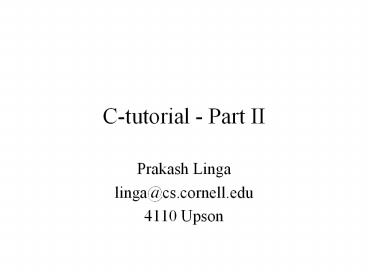C-tutorial - Part II - PowerPoint PPT Presentation
Title:
C-tutorial - Part II
Description:
C-tutorial - Part II Prakash Linga linga_at_cs.cornell.edu 4110 Upson – PowerPoint PPT presentation
Number of Views:110
Avg rating:3.0/5.0
Title: C-tutorial - Part II
1
C-tutorial - Part II
- Prakash Linga
- linga_at_cs.cornell.edu
- 4110 Upson
2
All about Strings!
- Array of characters (chars)
- Definition char str
- str is a pointer to a memory location which
stores a character (the first in the string). - How we know the end of the string?
- The character \0 (null character) indicates the
end of the string. - Where on earth is the string stored?
3
Strings
- In memory right!
- So allocate memory to store a string
- char str (char ) malloc(sizeof(char)MAXSTRLE
N) - How do I store the string now?
- Brute-force Store character by character.
- Better Approach Use strcpy
- Note What follows is mainly from SunOS man pages.
4
Sssss
- strcpy
- strcpy(chardestn, char source)
- include ltstring.hgt
- char str (char ) malloc(sizeof(char)MAXSTRLE
N) - strcpy(str, That was easy)
- What is the length of my string?
- Use strlen
- int len strlen(str)
5
Strings in Java
- Strings are Objects
- Creating a String is a call to one of the
constructors. - String str new String(This is ridiculously
easy! Why cant I do this in C?) - Host of methods in the String class
- length, trim, compareTo, substring, charAt,
concat, - indexOf , endsWith, replace
- to name a few.
6
Back to the Obscure World!
- We have a host of functions for string
manipulation in Ctoo - strcpy, strncpy, strlcpy
- strcat, strncat, strlcat
- strcmp, strncmp, strcasecmp, strncasecmp,
- strchr, strrchr, strstr, strlen
- strtok, strtok_r, strcspn, strspn, strdup, strpbrk
7
Copies
- char strcpy(char s1, const char s2)
- char strncpy(char s1, const char s2, size_t
n) - size_t strlcpy(char dst, const char src,
size_t dstsize) - strncpy copies over n bytes from the source to
the destination - (many questions here!!!???)
- strlcpy copies at most dstsize-1 characters
from src to dst, - truncating src if necessary. Result is always
null terminated. - (again many small questions!)
8
Cats
- Cats are similar to copies!
- char strcat(char s1, const char s2)
- char strncat(char s1, const char s2, size_t
n) - size_t strlcat(char dst, const char src,
size_t dstsize) - Any interesting questions here?
- strncat result is \0 terminated (always). This
is not the case - with strncpy
9
Compares
- int strcmp(const char s1, const char s2)
- int strncmp(const char s1, const char s2,
size_t n) - strcasecmp and strncasecmp are case insensitive
versions of - strcmp.
- Return values for strcmp
- Returns 0 if equal 1 if s1 gt s2 and 1
otherwise. - Note Use includeltstrings.hgt for strcasecmp and
strncasecmp
10
strchr, strrchr and strstr
- char strchr(const char s, int c)
- char strrchr(const char s, int c)
- char strstr(const char s1, const char s2)
- strchr
- Return a pointer to the first occurrence of c in
s - strrchr
- Return a pointer to the last occurrence of c in
s - strstr
- Return a pointer to the first occurrence of
string s2 in s1 - (any tricky case?)
11
Toks
- char strtok(char s1, const char s2)
- char strtok_r(char s1, const char s2,
char lasts) - The strtok() function can be used to break
the string pointed to by s1 into a sequence of - tokens, each of which is delimited by one or more
characters from the string pointed to by - s2.
- The first call (with pointer s1 specified)
returns a pointer to the first character of the
first - token, and will have written a null character
into s1 immediately following the returned - token.
- The function keeps track of its position in the
string between separate calls, so that - subsequent calls (which must be made with the
first argument being a null pointer) will - work through the string s1 immediately
following that token.
12
Strtok example
- include ltstring.hgt
- int main ()
- char str100
- char tmp
- strcpy(str, "This is a sample string,just
testing.") - printf ("Splitting \"s\" into tokens\n",str)
- tmp strtok (str," ,.")
- while (tmp ! NULL)
- printf ("s\n",tmp)
- tmp strtok (NULL, " ,.")
- return 0
13
Output of tok program
- Splitting "This is a sample string,just testing."
into tokens - This
- is
- a
- sample
- string
- just
- testing
14
Same example with strtok_r
- include ltstring.hgt
- int main ()
- char str100
- char tmp, last
- strcpy(str, "This is a sample string,just
testing.") - printf ("Splitting \"s\" into tokens\n",str)
- tmp strtok_r (str," ,. " , last)
- while (tmp ! NULL)
- printf ("s\n",tmp)
- tmp strtok_r (NULL, " ,. " , last)
- return 0
15
strspn and strcspn
- size_t strcspn(const char s1, const char s2)
- size_t strspn(const char s1, const char s2)
- The strcspn() function returns the length of
the initial - segment of string s1 that consists entirely of
characters - not from string s2.
- The strspn() function returns the length of the
initial segment - of string s1 that consists entirely of
characters from string - s2.
16
strdup
- char strdup(const char s1)
- Make a copy (allocates memory using malloc) of
the - parameter string and return a pointer to this
copy - char strpbrk(const char s1, const char s2)
- The strpbrk() function returns a pointer to
the first occurrence in - string s1 of any character from string s2, or a
null pointer if no character - from s2 exists in s1.































